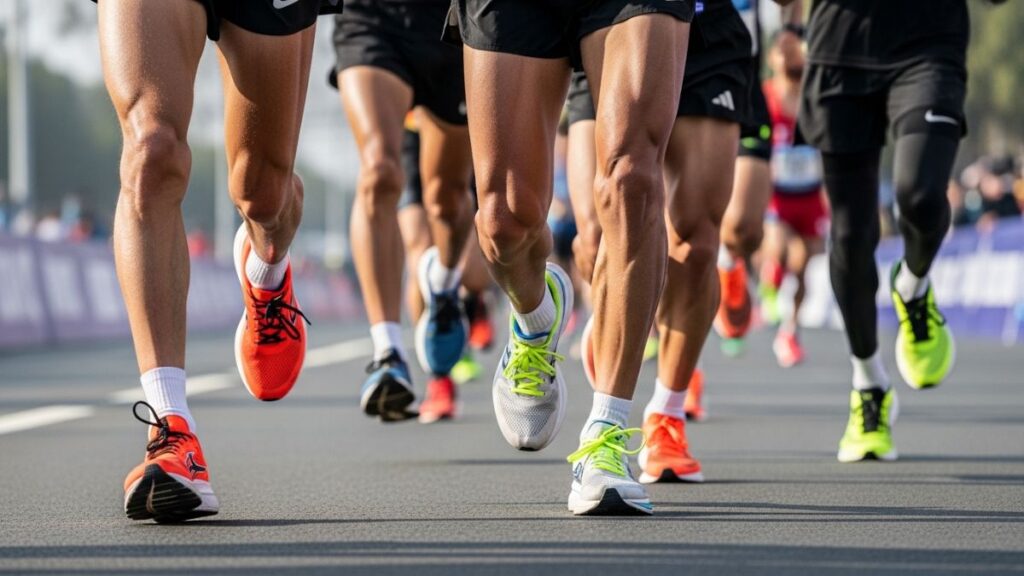
A 330 marathon pace means finishing a marathon in 3 hours and 30 minutes. To achieve this, you need to run at about 8 minutes per mile or 4 minutes and 58 seconds per kilometer. For many runners, this is a strong but realistic target if proper training is followed.
When runners hear “3:30 marathon pace,” they instantly want to know two things: how fast they need to run, and whether it’s within reach. The numbers are simple but powerful—8:00 per mile doesn’t sound extreme, but carrying it for 26.2 miles separates trained runners from casual joggers.
For context, a 3:30 finish time often puts runners near the front third of finishers at major marathons. It’s also a common Boston Marathon qualifying goal, especially for men under 40 and women in younger age groups. That makes it not just a personal milestone but also a widely respected benchmark in distance running.
What Does a 330 Marathon Pace Mean?
Breaking Down Time and Distance
A 3:30 marathon means finishing 26.2 miles in three hours and thirty minutes. To stay on track, you must average 8 minutes per mile or faster. This pace must be consistent from start to finish, leaving little room for slowing down late in the race. The math is straightforward: 3 hours and 30 minutes equals 210 minutes. Divide that by 26.2 miles, and you land at just over 8 minutes per mile. That steady rhythm is the heartbeat of the 330 marathon pace.
Pace Per Mile and Per Kilometer
The 330 marathon pace is about 8:00 per mile or 4:58 per kilometer. Both numbers are vital, depending on whether you train with miles or kilometers. Staying close to this rhythm every mile is what delivers the 3:30 finish time. Many runners use watches that display both mile and kilometer splits. This ensures they don’t slip off pace when fatigue sets in. Missing by just 15 seconds per mile early on can cost you several minutes at the finish line.
Who Usually Targets a 3:30 Finish?
Runners aiming for a 3:30 marathon are typically intermediate athletes with consistent training. They’ve usually completed several half-marathons or marathons already and are building toward stronger results. It’s not usually a first-timer’s goal, but rather a target for runners who’ve moved past “just finishing.” For many, a 3:30 finish qualifies them for prestigious races like Boston. It’s both a personal achievement and a competitive standard that proves endurance, discipline, and pacing ability.
Why Runners Aim for a 330 Marathon Pace
The Balance Between Speed and Endurance
Running a marathon in 3:30 requires steady endurance with controlled speed. The pace isn’t sprinting, but it’s not casual either. It challenges your aerobic capacity while demanding enough strength to hold form for over three hours. This time hits a sweet spot for many runners. It’s quick enough to feel competitive, yet realistic for dedicated amateurs who follow structured training. It asks for discipline across months of preparation, not just raw speed on race day.
Marathon Standards and Qualifying Goals
A 3:30 finish time is a common qualifying target for the Boston Marathon and other major races. For men under 40, 3:30 is often the cut-off, while for many women, it’s considered a competitive benchmark. This makes the 3:30 goal more than just personal pride—it’s a ticket to world-famous events. Chasing this time aligns with long-term aspirations, like securing a Boston bib or achieving a top age-group finish. It’s why many runners call 3:30 a gateway goal in their marathon careers.
Comparing 3:30 With Other Marathon Benchmarks
A 3:30 marathon sits between casual completion and elite-level times. It’s faster than the global average finish time of 4:20–4:30, but slower than the sub-3 elite amateur mark. To put it in perspective, a 4:00 marathon equals about 9:09 per mile, while 3:30 requires 8:00 per mile. That 69-second difference per mile may seem small, but over 26.2 miles, it adds up to a huge performance gap. The 3:30 pace is proof of both fitness and strategy.
Training Strategies for Holding a 330 Marathon Pace
Base Mileage and Weekly Running Volume
To run a 3:30 marathon, most runners need 40–55 miles per week during peak training. This base mileage builds the aerobic foundation needed to hold pace for 26.2 miles. Building gradually is key. Many training plans start at 25–30 miles per week and increase by 10% until peak weeks. Consistency matters more than spikes in mileage. Missing base training often leads to breakdown in the later miles.
Tempo Runs and Race Pace Practice
Tempo runs at or slightly faster than 8:00 per mile train the body to handle marathon pace under controlled fatigue. This teaches efficiency and pacing discipline. A typical tempo workout might be 20–40 minutes at race pace within a longer run. Over time, this makes 3:30 pace feel natural. Without tempo practice, many runners either overcook early miles or struggle to lock in rhythm.
Long Runs With Pace Segments
Long runs are the backbone of marathon training, and including 6–10 miles at 3:30 pace within them is essential. These runs simulate race-day fatigue and prepare the body to stay efficient late. A strong example is a 20-mile long run with the last 8 miles at 8:00 pace. This type of workout builds mental toughness and endurance. It mimics the hardest part of race day when legs are tired but pace must be held.
Interval Workouts to Build Speed
Interval training builds the speed and strength required to handle 3:30 pace. Common intervals include 800m, 1K, or mile repeats run faster than goal pace.
For example: 6 x 1 mile at 7:15 pace with short recovery trains the legs to move faster than needed. This makes the actual marathon pace feel more controlled. Intervals also improve running economy, which lowers the energy cost of each stride.
Strength Training and Core Work
Strength and core training reduce injury risk and improve running form, both critical for a 3:30 marathon. A strong core helps maintain posture when fatigue sets in during the final miles. Runners who include squats, lunges, planks, and stability drills in their weekly plan often see fewer injuries. Even two 30-minute sessions per week can make a noticeable difference in durability and efficiency.
Nutrition and Hydration for a 330 Marathon Pace
Pre-Race Fueling Strategy
For a 3:30 marathon, carb loading in the 2–3 days before the race is crucial. Most runners aim for 7–10 grams of carbs per kilogram of body weight to top up glycogen stores. This doesn’t mean overeating; it means adjusting the plate. Rice, pasta, potatoes, bread, and fruit should make up most meals. A balanced dinner the night before and a light breakfast 2–3 hours pre-race give enough energy without stomach distress.
Fueling During Long Runs and Races
During a 3:30 marathon, runners typically need 45–60 grams of carbs per hour. Energy gels, sports drinks, or chews spaced every 30–40 minutes help maintain pace and delay fatigue. Training the gut is as important as training the legs. Practicing fueling on long runs teaches the body to absorb carbs while running at 8:00 pace. Skipping fuel often results in “hitting the wall” around mile 20, when glycogen runs low.
Hydration and Electrolyte Balance
Hydration at 330 marathon pace means drinking to thirst while ensuring sodium intake. Most runners lose 400–800mg of sodium per hour, which must be replaced through sports drinks or salt tabs. Overhydration can be as dangerous as dehydration. The key is balance: small, steady sips at aid stations combined with electrolytes. Practicing this in long runs ensures the stomach tolerates the intake on race day.
Mental Preparation and Pacing Discipline
Breaking the Race Into Sections
The easiest way to handle a 3:30 marathon pace is to mentally divide the race into smaller chunks. Instead of thinking about 26.2 miles, focus on 5K or 10K blocks. This approach prevents mental overload. By breaking the distance into sections, runners stay motivated and more in control. Each segment becomes a checkpoint where focus can reset, making the full marathon feel less daunting.
Handling Fatigue and Negative Splits
Fatigue is guaranteed, but the strategy is to conserve energy early and finish stronger. Running the second half slightly faster than the first—a negative split—is the safest way to hit 3:30. Starting too quickly is one of the biggest mistakes. Holding steady for the first half and gradually pushing in the final 10K ensures energy is available when others fade. Mental toughness at this stage often makes the difference between 3:29 and 3:35.
Visualization and Mental Focus
Visualization helps prepare for tough moments in the race. Picture yourself running smoothly at 8:00 pace, handling fatigue, and crossing the finish line under 3:30. Mental cues like “relax your shoulders” or “smooth stride” keep form strong when the body is tired. Training the mind is just as important as training the legs. On race day, mental focus often carries runners through the final 10 kilometers when physical energy dips.
Common Mistakes When Chasing a 330 Marathon Pace
Starting Too Fast
One of the biggest errors runners make when targeting a 3:30 marathon pace is going out too fast in the early miles. The adrenaline of race day and the excitement of the crowd can lead you to push harder than planned, but this often results in burning through glycogen stores too quickly and struggling later in the race. Staying disciplined at the start ensures your energy lasts through the final miles.
Skipping Race Pace Practice
Many runners train hard but forget to regularly practice their actual goal pace during long runs and tempo sessions. Without race pace rehearsal, it becomes difficult to internalize what a 3:30 pace feels like and sustain it under fatigue. Incorporating dedicated pace runs into training teaches your body to handle the rhythm and effort needed to stay consistent on race day.
Neglecting Recovery and Sleep
Training for a 3:30 marathon requires intensity, but overlooking recovery and sleep can derail your progress. Without enough rest, muscles don’t repair properly, energy levels drop, and injuries become more likely. Prioritizing sleep, active recovery, and rest days is just as important as completing workouts, ensuring your body is fresh and ready to perform at its best.
Tools and Technology to Stay on Track
GPS Watches and Pace Alerts
A GPS watch is one of the most reliable tools for maintaining a steady 3:30 marathon pace. These devices track your distance, splits, and current pace in real time, helping you avoid the mistake of going out too fast or too slow. Setting up pace alerts ensures you stay within your target range and develop consistency across training and race day.
Using Training Apps and Plans
Training apps and structured plans make it easier to follow a program specifically designed for a 3:30 marathon goal. Apps provide detailed workout schedules, long run guidance, and track progress so you know when to push harder or back off. Many also offer built-in pace calculators and adaptive features, making them valuable for runners who want tailored support and accountability.
The Role of Heart Rate Monitoring
Heart rate monitoring adds another layer of insight into your training. By tracking your heart rate, you can ensure you are running at the right intensity for easy runs, tempo workouts, and long runs. This prevents overtraining and helps you recognize when your body needs recovery. On race day, it also keeps you from pushing into unsustainable zones too early.
Data-Driven Insights on the 3:30 Marathon Pace
Aiming for a 3:30 marathon finish requires both strategic pacing and an understanding of how this target compares to broader marathon standards. By looking at pacing breakdowns and qualification statistics, runners can see how their goal aligns with official benchmarks and global race performances.
Pacing Breakdown for a 3:30 Marathon
To finish in 3 hours and 30 minutes, runners must sustain a steady pace throughout the 26.2 miles (42.195 km). Here’s a breakdown:
|
Distance |
Target Split Time |
Average Pace |
|
1 mile |
~8:00 |
8:00 min/mile |
| 5K | ~25:00 |
5:00 min/km |
|
10K |
~50:00 |
5:00 min/km |
|
Half Marathon (21.1 km) |
~1:45:00 |
8:00 min/mile |
| 30K | ~2:30:00 |
5:00 min/km |
| Marathon (42.2 km) | 3:30:00 |
8:00 min/mile |
This means a runner must hold close to 8 minutes per mile (5:00/km) without major drop-offs, especially in the later stages of the race.
Boston Marathon Qualification Context
The Boston Marathon is often the gold standard for competitive runners. As of recent qualification standards:
- Men aged 18–34 need a 3:00:00 marathon or faster.
- Women aged 18–34 need a 3:30:00 marathon or faster.
This shows that for younger female runners, a 3:30 marathon is Boston-qualifying pace, while for men it’s still a strong but non-qualifying time.
Global Finisher Data
Looking at worldwide marathon results:
- The average marathon finish time is around 4:30:00, which is about an hour slower than 3:30.
- A 3:30 finish puts runners roughly in the top 25% of marathon finishers globally, depending on the race.
Real Runner Experiences With a 3:30 Marathon Pace
Learning from real runners who have chased the 3:30 marathon mark helps reveal both the challenges and strategies behind this goal. Whether it’s first-timers, experienced athletes, or those who narrowly missed, their experiences provide insight you can apply to your own training.
Case Studies From Amateur Runners
Amateur runners often see the 3:30 marathon as a reachable but ambitious goal. For example, one runner starting with a 4:15 marathon cut nearly 45 minutes by following a structured plan that included tempo runs and strength training. Another runner built their mileage slowly over 18 months, eventually hitting 3:29 by consistently practicing long runs at target pace. These examples show that everyday athletes can succeed with patience, discipline, and gradual progression.
How Experienced Runners Train Differently
Runners with more racing experience often approach the 3:30 pace with precision. Instead of simply logging miles, they use structured intervals, incorporate marathon-pace sections into long runs, and closely monitor heart rate data. They also pay more attention to recovery, hydration strategies, and shoe selection. While beginners may focus on building endurance, experienced runners fine-tune the small details that can shave seconds off each mile and prevent late-race fatigue.
Lessons Learned From Missed Attempts
Not every runner chasing 3:30 hits the target on their first try. Common lessons emerge from those who missed:
- Starting too fast: Several runners admitted going out at 7:40 per mile, only to burn out by mile 18.
- Ignoring fueling: A few underestimated carbohydrate intake during the race and saw their energy collapse.
- Skipping pace practice: Others realized they hadn’t trained enough at exactly 8:00 per mile, making race day pacing feel unnatural.
These lessons underline the importance of discipline, nutrition, and realistic training for anyone targeting this goal.
Building Toward the 3:30 Marathon Pace
Chasing a 3:30 marathon isn’t an overnight project. It requires the right training adjustments, a realistic timeline, and the awareness that once you reach it, new goals may soon follow.
Adjusting Training for Different Levels
Not every runner starts at the same baseline. For beginners with marathon times above 4 hours, the path often means gradually lowering finishing times across multiple races. Intermediate runners closer to 3:45 may only need a few training cycles with focused race-pace work to close the gap. More advanced runners with strong half-marathon times might already have the aerobic fitness to shift toward 3:30 by refining their endurance and pacing.
How Long It Takes to Train for 3:30
Most runners need 4 to 12 months of structured training to prepare for a 3:30 marathon. The exact timeline depends on starting fitness, injury history, and consistency. A runner beginning at 4:00 pace might need a full year with two marathon cycles, while someone already running 3:40 could achieve it in one cycle. Training plans usually last 16 to 20 weeks, with gradual mileage increases and specific workouts that build pace confidence.
Moving Beyond 3:30 Once Achieved
For many, 3:30 is a milestone rather than the finish line. Some chase the 3:20 barrier next, while others focus on qualifying standards like Boston. Beyond time goals, runners often explore ultra-distance races or shift focus to half-marathon performance. Hitting 3:30 builds a foundation of strength and pacing discipline that makes further improvements more achievable.
Conclusion
Running a marathon in 3:30 is all about balance. It means holding 8:00 minutes per mile or 4:58 per kilometer for the entire race. To reach that goal, you need steady mileage, structured workouts, smart fueling, and consistent pacing.
Every section of training matters. Base mileage builds endurance, tempo runs sharpen pace control, long runs test your limits, and recovery keeps your body ready. Add in nutrition, hydration, and mental focus, and you create a complete system that makes 3:30 realistic.
If there’s one takeaway, it’s this: the 3:30 marathon pace is achievable with smart, steady training, not shortcuts. Stick to the plan, track your progress with data, and avoid common mistakes like starting too fast. When you line up on race day, you’ll know you’re prepared to run strong from start to finish.
FAQs
Is a 3:30 marathon good?
Yes, a 3:30 marathon is considered a strong time. It places you faster than the majority of marathon finishers worldwide. For men, it often sits within the top 25% of results, and for women, it’s closer to the top 10–15%.
What pace per mile is needed for 3:30?
You need to run 8:00 minutes per mile to finish in 3:30. If measured in kilometers, that equals about 4:58 per km. Holding this pace steadily for 26.2 miles or 42.2 kilometers brings you right to a 3:30 finish.
Can a beginner achieve a 3:30 marathon?
Most beginners can’t run 3:30 on their first marathon. It usually takes multiple training cycles and building experience with shorter races like the half marathon. That said, a beginner with a strong athletic background could aim for it after proper preparation.
Is 3:30 fast enough for Boston qualification?
For many runners, yes. The Boston Marathon qualifying standards vary by age and gender. For example, men ages 18–34 need a 3:00 standard, while women in that group need 3:30. For older age brackets, 3:30 often meets or beats the cutoff.
How long should I train to reach 3:30?
Most runners need 4–12 months of focused training. If you’re already near 3:40, a single training cycle may be enough. If you’re starting closer to 4:00 or slower, expect to put in a year of consistent work before attempting a 3:30 goal.







